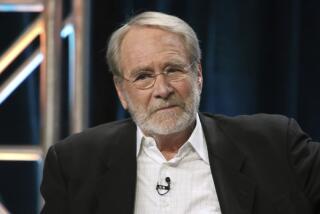IMPRESARIO OF ODDBALL THEATER
- Share via
“Art is not my life,” announced performance artist Chris Sullivan, whose “The Old Mill” arrives today for two nights only--at Los Angeles Contemporary Exhibitions (LACE). “It’s important to me, but it’s not who I am. It’s a job . . . granted, a very pleasant job.
“I’m doing what I do because it was defined at some point that I had a particular aptitude,” continued the Minneapolis-based artist. “It doesn’t mean I don’t care, don’t have passion. I care very much that my work says something, is historically important. What I don’t care about is that elitist thing of being known as an artist. I’m not trying to demean my art--it just doesn’t define me as a viable human being. Some artists are terrible people, some cooks are great.”
That said, Sullivan, 27, is happy to describe “The Old Mill,” a theatrical piece enacted by him, Michelle Kinney and Michael Sommers. They all take turns as performers, puppeteers, singers and musicians (with Sullivan on guitar and saw, Kinney on cello and keyboards and Sommers on drums and percussion).
“It’s based on a vagrant who lives across the street from me,” he explained. “There’s a certain grudging energy in the neighborhood that goes into supporting him. He mows the lawn, does grocery shopping (while managing to filch beer for himself). The piece is about being a powerful victim--the power of helplessness. For me, it relates to thoughts about apathy, dealing with people, victims and saviors.”
As for the very real issue of homelessness, the Pittsburgh native acknowledged that that sociological arena “is pretty much left alone. Danny, my character, isn’t your typical homeless person. I’m using him more as (an image of) an extreme. Someone once reviewed this and said, ‘It looks at loopholes in Darwinian logic.’ That’s an interesting point: that there’s a place in society for this kind of waiflike, context-less, non-linear person.”
Oddball characters aren’t the only unusual feature here. Sullivan (whose body of work includes 10 performance pieces, seven films and multiple grants from the American Film Institute and National Endowment for the Arts) warned that the telling of the story is equally unconventional.
“Basically it’s a vaudevillian presentation, a dialogue between the three characters on stage. And it’s played in an obnoxiously theatrical way, like Gilbert and Sullivan: We overenunciate, turn out too much toward the audience, give a real presentation. There’s no illusion that these people are really having a conversation. Since I come from an arts background (he studied at Carnegie-Mellon and the Minneapolis College of Art and Design), I’m always dealing with the awareness of the falseness of the set, memorized lines . . . and then feeling comfortable with that falseness.
“A lot of (the performance) is based on language,” he added; “listening to the text, which is very specific: a lot of archaic words, narrative poems--it has a real British feel. I guess the experience is more like reading than a reacting to something on stage. Although, sure, the visual is important. I tend to be (visually) very bombastic, loud. There are no subtle metaphors. At one point in the story a dog gets hit by a car. So we throw this big bloody dog (prop) around with noisemakers inside it.”
Sullivan also relies on marionettes, miniaturized sets “and very blatant costumes. For instance, my character wets his pants; (accordingly) my pants are always wet. Another character wears corrective shoes, a very blatant image. So there’s always something to look at and relate to--even though you’re not relating to them as real people. Instead of being plumbers and housewives, they’re larger than life: giants, ogres, kings and queens--but in a present-day context.”
More to Read
The biggest entertainment stories
Get our big stories about Hollywood, film, television, music, arts, culture and more right in your inbox as soon as they publish.
You may occasionally receive promotional content from the Los Angeles Times.










